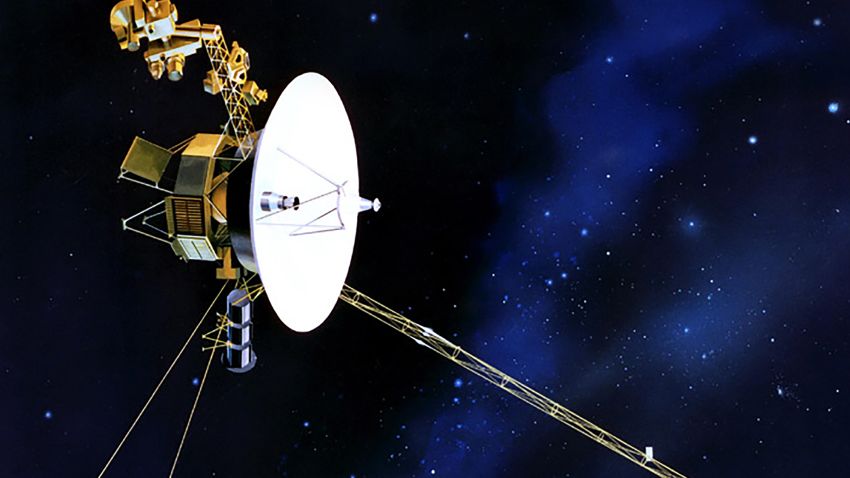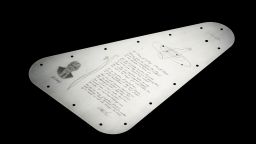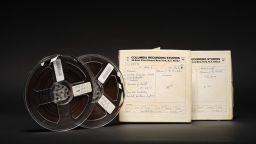Sign up for CNN’s Wonder Theory science newsletter. Explore the universe with news on fascinating discoveries, scientific advancements and more.
Engineers have sent a “poke” to the Voyager 1 probe and received a potentially encouraging response as they hope to fix a communication issue with the aging spacecraft that has persisted for five months.
Launched in 1977, Voyager 1 and its twin, Voyager 2, are venturing through uncharted cosmic territory along the outer reaches of the solar system.
While Voyager 1 has continued to relay a steady radio signal to its mission control team on Earth, that signal has not carried any usable data since November, which has pointed to an issue with one of the spacecraft’s three onboard computers.
A new signal recently received from the spacecraft suggests that the NASA mission team may be making progress in its quest to understand what Voyager 1 is experiencing. Voyager 1 is currently the farthest spacecraft from Earth at about 15 billion miles (24 billion kilometers) away.
Meanwhile, Voyager 2 has traveled more than 12.6 billion miles (20.3 billion kilometers) from our planet. Both are in interstellar space and are the only spacecraft ever to operate beyond the heliosphere, the sun’s bubble of magnetic fields and particles that extends well beyond the orbit of Pluto.
Initially designed to last five years, the Voyager probes are the two longest-operating spacecraft in history. Their exceptionally long life spans mean that both spacecraft have provided additional insights about our solar system and beyond after achieving their preliminary goals of flying by Jupiter, Saturn, Uranus and Neptune decades ago.
But both probes have faced challenges along the way as they age.
Cosmic communication breakdown
The mission team first noticed the communication issue with Voyager 1 on November 14, 2023, when the flight data system’s telemetry modulation unit began sending a repeating pattern of code.
Voyager 1’s flight data system collects information from the spacecraft’s science instruments and bundles it with engineering data that reflects the current health status of Voyager 1. Mission control on Earth receives that data in binary code, or a series of ones and zeroes.
But since November, Voyager 1’s flight data system has been stuck in a loop.
The spacecraft can still receive and carry out commands transmitted from the mission team, but a problem with that telecommunications unit meant no science or engineering data from Voyager 1 was transmitting to Earth.
Since discovering the issue, the mission team has attempted sending commands to restart the computer system and learn more about the underlying cause of the issue.
The team sent a command, called a “poke,” to Voyager 1 on March 1 to get the flight data system to run different software sequences in case some type of glitch was causing the issue.
On March 3, the team noticed that activity from one part of the flight data system stood out from the rest of the garbled data. While the signal wasn’t in the format the Voyager team is used to when the flight data system is functioning as expected, an engineer with NASA’s Deep Space Network was able to decode it.
The Deep Space Network is a system of radio antennas on Earth that help the agency communicate with the Voyager probes and other spacecraft exploring our solar system.
The decoded signal included a readout of the entire flight data system’s memory, according to an update NASA shared.
“The (flight data system) memory includes its code, or instructions for what to do, as well as variables, or values used in the code that can change based on commands or the spacecraft’s status,” according to a NASA blog post. “It also contains science or engineering data for downlink. The team will compare this readout to the one that came down before the issue arose and look for discrepancies in the code and the variables to potentially find the source of the ongoing issue.”
How the Voyager probes keep going
Voyager 1 is so far away that it takes 22.5 hours for commands sent from Earth to reach the spacecraft. Additionally, the team must wait 45 hours to receive a response. Currently, the team is analyzing Voyager 1’s memory readout after initially beginning the decoding process on March 7 and finding the readout three days later.
“Using that information to devise a potential solution and attempt to put it into action will take time,” according to the space agency.
The last time Voyager 1 experienced a similar, but not identical, issue with the flight data system was in 1981, and the current problem does not appear to be connected to other glitches the spacecraft has experienced in recent years.
Over time, both spacecraft have encountered unexpected issues and dropouts, including a seven-month period in 2020 when Voyager 2 couldn’t communicate with Earth. In August 2023, the mission team used a long-shot “shout” technique to restore communications with Voyager 2 after a command inadvertently oriented the spacecraft’s antenna in the wrong direction.
As the aging twin Voyager probes continue exploring the cosmos, the team has slowly turned off instruments on these “senior citizens” to conserve power and extend their missions, Voyager’s project manager Suzanne Dodd previously told CNN.






